Chakras: What do they mean and their origin?
What are Chakras? A simple guide
You've probably heard about chakras and their function in the body's energy flow if you've ever taken a yoga or meditation class, had an energy healing session like reiki, or even watched online videos about those subjects.
You may also be familiar with the need to keep the chakras "open" or "unblocked" for better mental and physical health.
But do you know what chakras are or where they come from? This is what this article is going to focus on. We'll also break down the effects chakras have and how to keep them "open" to boost your health.
What are Chakras?
Chakras are an ancient concept, originating in India over 5000 years ago. The word "chakra" comes from the Sanskrit language, and it means a "disc" or a "wheel." These discs refer to the energy centres in your body. Each of these discs of energy is connected to a nerve bundle or major organ.
It shouldn't come as a surprise that these chakras hold importance in religion too. In Hinduism and Buddhism, chakras are places in the body where energy, called "prana", gathers.
In many kinds of Hinduism, there are seven. In Buddhism, there are four main chakras. It is said that these seven chakras are connected by "Nadi", which are energy channels. The idea of chakras has influenced many holistic medical practices around the world, like yoga, Ayurveda, and some newer therapies like sound baths.
Chakras are often represented as swirling wheels of energy, each with its colour and vibration frequency. Each chakra gives off a certain colour and energy. Early Hindu ideas about a physical body and a subtle body are linked to the idea of chakras. The physical body has mass and can be seen, but the subtle body, which includes the mind and feelings, is made of energy and can't be seen.
In this system, the subtle body's spiritual or psychic energy affects the physical body, and vice versa.
Where did chakras originate?
The Vedas, which are ancient Indian texts, first mention chakras as a part of their discussion of yoga philosophy.
European spiritualists and occultists wrote about Tantra and chakras in the early 20th century. These books define Western chakras today. 20th-century Western thinkers linked chakras to rainbow colours. Since then, chakras have represented various things like metals, zodiac foods, herbs, minerals, or tarot cards The "Western chakra system" is a new approach to chakras. Crystal healing and homoeopathy have been influenced by it. This new Western chakra system has taken on a life of its own, allowing the interpretation of chakras to become more personal.
How many chakras are there?
Humans have an infinite number of chakras, but we usually hear about the "seven chakras." All seven chakras have a vibration, colour, symbol, and sound. Your physical, mental, and emotional health depend on whether these energy centres are healthy or blocked. The body's seven main chakras are:
1. Root Chakra (Muladhara)
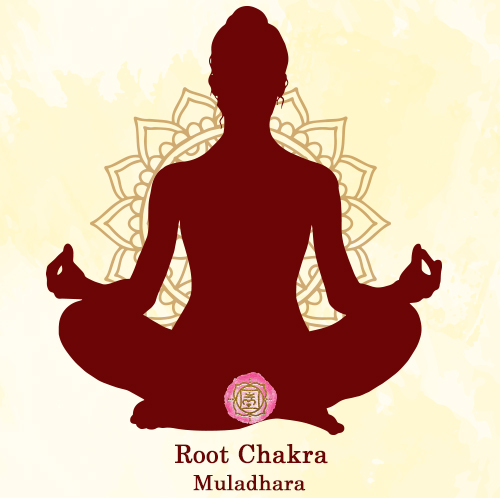
The Muladhara also called the root chakra, is our base. It is found at the base of the human spine and provides us with a sense of security. When the root chakra is open, we feel sure that we can handle challenges and stand on our own. When it’s blocked, we feel like we’re in danger and like we’re on unstable ground.
Symbol: The root chakra symbol is a lotus flower with four petals, a square, and a triangle that points down. It is said that each element represents one of the four parts of the human mind. When these four parts come together, it is said that consciousness is born.
Colour: Red
Element: Earth
Signs that your root chakra is blocked: When this chakra is out of balance, a person starts to feel unstable, ungrounded, without ambition or purpose, afraid, insecure, and frustrated.
Signs that your root chakra is balanced: When the root chakra is balanced, you experience more uplifting emotions instead of these negative ones, and you feel strong, independent, energetic, and stable.
2. Sacral Chakra (Swadhisthana)
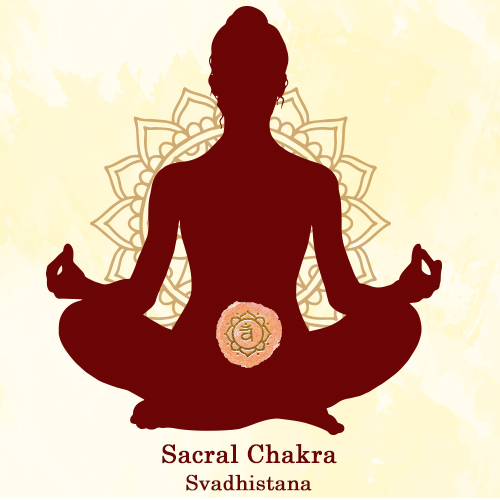
The Swadhisthana, also called the sacral chakra, helps us understand how to deal with our feelings and the feelings of other people. It also controls sexual energy and creative energy. If your sacral chakra is blocked, you might feel like you don’t have control over your life.
Location: Lower abdomen, 2 inches below the belly button
What it controls: It controls how you feel about money, happiness, pleasure, and sexuality.
Symbol: The Svadhishthana Chakra, also called the Sacral Chakra, is represented by a group of circles, a crescent moon, and six lotus petals. The circles and crescent moon show how life, death, and rebirth happen in cycles, while the six petals show the six bad parts of ourselves that we need to change to open this chakra.
Colour: Orange
Element: Water
Signs that your sacral chakra is blocked: When the sacral chakra is out of balance, a person may feel emotionally explosive and irritable, lack energy and creativity, be manipulative, or be obsessed with sexual thoughts.
Signs that the sacral chakra is in balance: When it is in balance, it makes a person feel more alive, happy, positive, satisfied, caring, and intuitive.
3. Solar Plexus Chakra (Manipura)
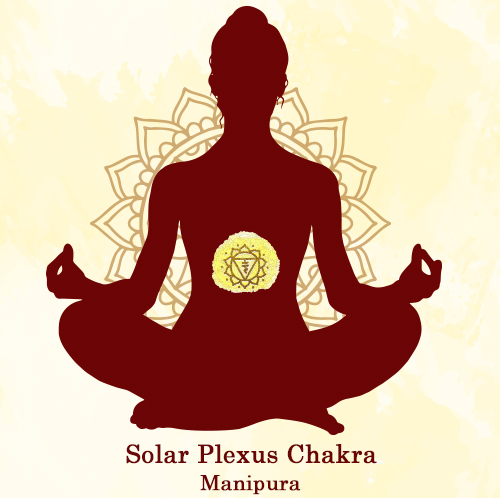
The solar plexus chakra is related to your ability to be confident. If your solar plexus chakra is blocked, you might feel a lot of shame and doubt about yourself. Those whose sacral chakras are open are free to show who they are.
Location: in the stomach, in the upper abdomen.
What it controls: self-esteem, self-worth, and confidence
Symbol: The solar plexus chakra symbol is a ten-petal lotus with a downward-pointing triangle. The triangle represents our inner strength, and the ten petals represent ten bad traits we need to get rid of.
Colour: Yellow
Element: Fire
Signs that your solar plexus chakra is blocked: If the solar plexus chakra is out of balance, it can cause digestive problems, problems with the liver, or diabetes. On an emotional level, a person might have problems with depression, low self-esteem, anger, or trying to be perfect.
Signs that your solar plexus chakra is in good shape: When this chakra is balanced, we feel more energised, confident, productive, and present.
4. Heart Chakra (Anahata)
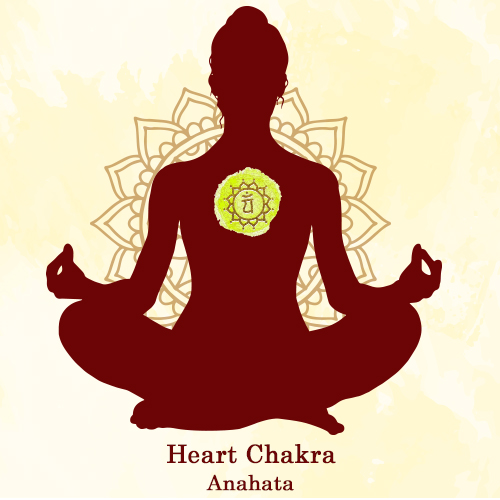
The Anahata, or heart chakra, is the link between the lower chakras (which deal with material things) and the higher chakras (associated with spirituality). As its name suggests, this chakra can affect our ability to give and receive love, both from others and from ourselves.
Location: Center of chest
What it controls: Love, and inner peace.
Symbol: In the Heart Chakra symbol, two triangles meet to make a yantra, which shows how yin and yang, or upward and downward forces, are in balance. Outside, there is a lotus flower with 12 petals that represent the heart’s twelve divine qualities.
Colour: Green
Element: Air
Signs that your chakra is blocked or out of balance: When the heart chakra is out of balance, a person may have problems with anger, lack of trust, anxiety, jealousy, fear, and moodiness.
Signs that your heart chakra is in balance: When this energy centre is in balance, a person starts to feel more caring, hopeful, friendly, and motivated.
5. Throat Chakra (Vishuddha)
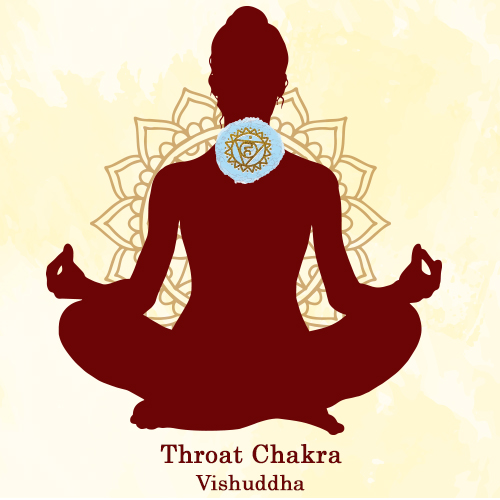
The throat chakra, or Vishuddha, gives the heart chakra a voice and controls how well we can talk about our power.
Location: in the throat
What it control: talking, expressing yourself, and telling the truth.
Symbol: The Throat Chakra’s symbol is a lotus flower with 16 petals surrounding an upside-down triangle with a circle in the middle. This shows spiritual growth and the cleansing of the body, mind, and spirit.
Colour: Blue
Element: Space
Signs that the Throat Chakra is blocked: If the throat chakra is blocked, we might feel shy, quiet, or weak, or we might not be able to say what we’re thinking.
Signs of a balanced throat chakra: When this chakra is in balance, it lets you be creative, positively express yourself, communicate constructively, and feel satisfied.
6. Third-Eye Chakra (Ajna)
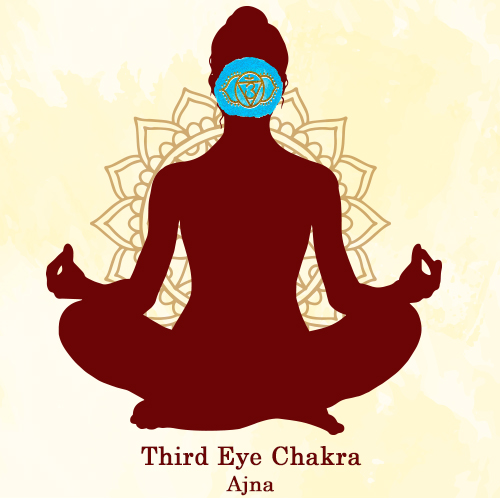
The third-eye chakra, also called the Anja, controls our ability to see the big picture and connect with our intuition. Imagine it as the soul’s eye: It takes in more than just the most obvious information. When the third-eye chakra is open, people often have visions and intuitive hits.
Location: Between the eyes (also called the brow chakra),
What it controls: It has power over intuition, creativity, and wisdom.
Symbol: The Third Eye Chakra symbol is an upside-down triangle between two lotus petals in a circle. Both the two petals and the downward-pointing pyramid represent wisdom, which highlights the role of the Third Eye Chakra in our journey to spiritual awareness.
Colour: Indigo
Element: None
Signs that your third eye chakra is blocked: When it’s out of whack, it can make you feel weak and afraid of success, or it can make you more self-centred. Headaches, blurry vision, and eye strain are all signs of an imbalance in the body.
Signs of a balanced Third Eye Chakra: When this chakra is active and in balance, a person feels more spiritually and emotionally alive and sure of themselves. When you don’t worry about dying, you become your boss and don’t get attached to material things.
7. Crown Chakra (Sahasrara)
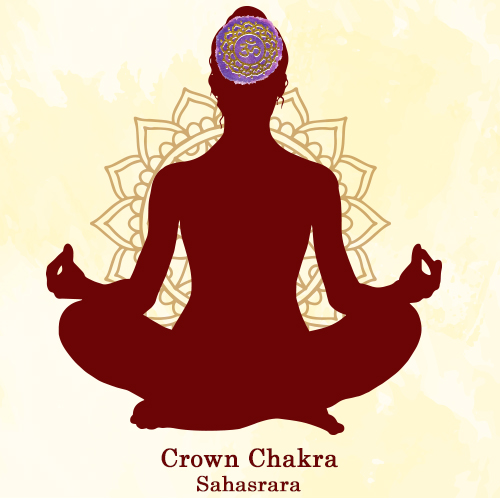
The crown chakra also called the Sahasrara, is the most important one. It sits at the top of the head and shows that we can be fully spiritually connected. When your crown chakra is fully open, which is something very few people ever do, you can reach a higher level of consciousness.
Location: right on top of the head
What it controls: beauty on the inside and out and spiritual connection.
Symbol: The Crown Chakra is represented by a picture of a thousand lotus petals in a circle around an upside-down triangle. This shows that divine energy is rising into the crown chakra and bringing spiritual freedom and enlightenment.
Colour: Violet.
Element: None
Signs that your crown chakra is blocked: When it gets out of balance, a person may feel frustrated, sad, and destructive all the time.
Signs that your Crown Chakra is in balance: A balanced Crown Chakra helps you understand your spiritual self, find inner peace, and see the world.
Summary
Chakras are a spiritual idea that is part of some of the world's most important religions and some alternative health practices. Supporters say that they are energy wheels that show where the life force meets. In Hinduism, one way to find spiritual enlightenment is to work with or master these chakras. Even though there isn't a lot of scientific proof that chakras are important to health and well-being, there are many practises that people use to balance or unblock chakras that are good for health. For instance, yoga and meditation may help calm the nervous system, which could help with many health problems. People can feel better and be more at peace when they use safe chakra-based therapies along with their medical care. But they are not a replacement for getting medical help.